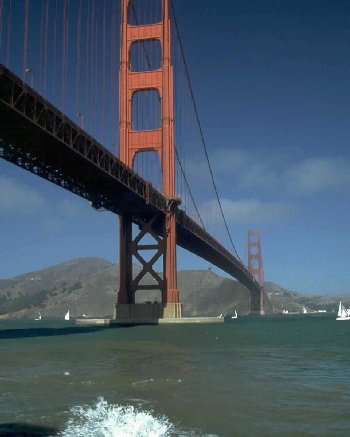Golden Gate Bridge
Today, we wait 90 years for a bridge. The University of Houston's College of Engineering presents this series about the machines that make our civilization run, and the people whose ingenuity created them.
In 1849 the steamer Panama sailed out of San Francisco Bay into the Pacific. My great-grandfather was on it, and so too was General John Fremont's family. Fremont had just called the mouth of the bay the "Golden Gate." The name captured the forbidding beauty of that great portal to Western America, and it caught on. When Great Grandpa crossed the bay again a year later, it was in a steamboat that'd been named the Golden Gate.
Public demand for a Golden Gate Bridge began as soon as the gold rush. But it was 70 years before the city engineer of San Francisco thought technology was actually up to making such a thing. In 1917 he turned to Joseph Strauss. The 5-foot Strauss -- a leading bridge builder -- said he could build a bridge to hell, if he were given enough money to do it.
The bridge was finally begun 16 years later. In the meantime, the railroads had fought it because it would eliminate the need for many trains. The War Department had questioned whether it would hurt navigation. The Depression delayed raising the 35-million-dollar cost. Years were lost in what was later called the "War of the Professors," as geologists haggled over the solidity of the floor of the bay. And all the while Strauss kept changing the design of the bridge.
He didn't settle on the present design until 1930, and a bold one it was. Its 4200-foot central span made it much longer than any suspension bridge that'd ever been attempted. The suspension cables were a major problem. Viewed from Berkeley, they look like a gossamer spider web. But they're 3 feet in diameter and woven from 25,000 individual strands.
The rule of thumb was that bridges cost one human life for every million dollars' worth of construction. Strauss wasn't about to offer 35 human sacrifices for his bridge. He created a gigantic rope net for his workers. So many people fell into it and survived that they formed a "Halfway to Hell Club." Strauss was first to make his workers wear hard hats. After four years, only one workman had died. Then a traveling platform came loose, plunged through the net, and killed another ten.
But the Golden Gate Bridge finally opened in 1937. The tape came down, and 200,000 pedestrians spilled across the span in the morning fog. Strauss was worn out -- he lived only another year. But this diminutive man had made his titanic masterpiece. He'd come in 1.3 million dollars under the estimate; and he'd given us one of the most beautiful things ever made. I only wish my great grandfather could have seen it.
I'm John Lienhard, at the University of Houston, where we're interested in the way inventive minds work.
(Theme music)
Lienhard, J. Heinrich, A Pioneer at Sutter's Fort (M. Wilbur, transl. and ed.). Los Angeles: The Califia Society, 1941.
Coel, M., A Bridge that Speaks for Itself. American Heritage of Invention and Technology, Summer 1987, pp. 8-17.

clipart